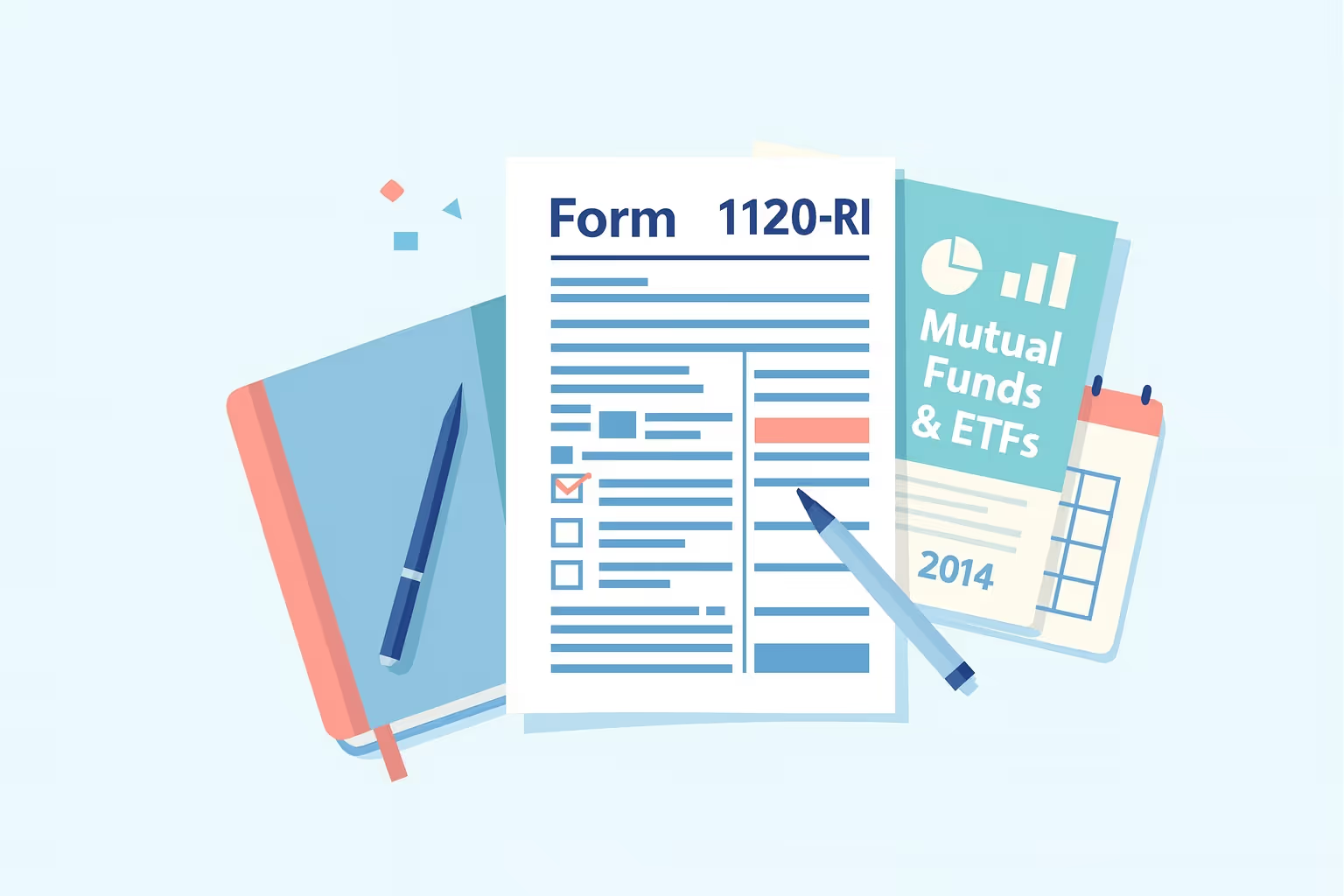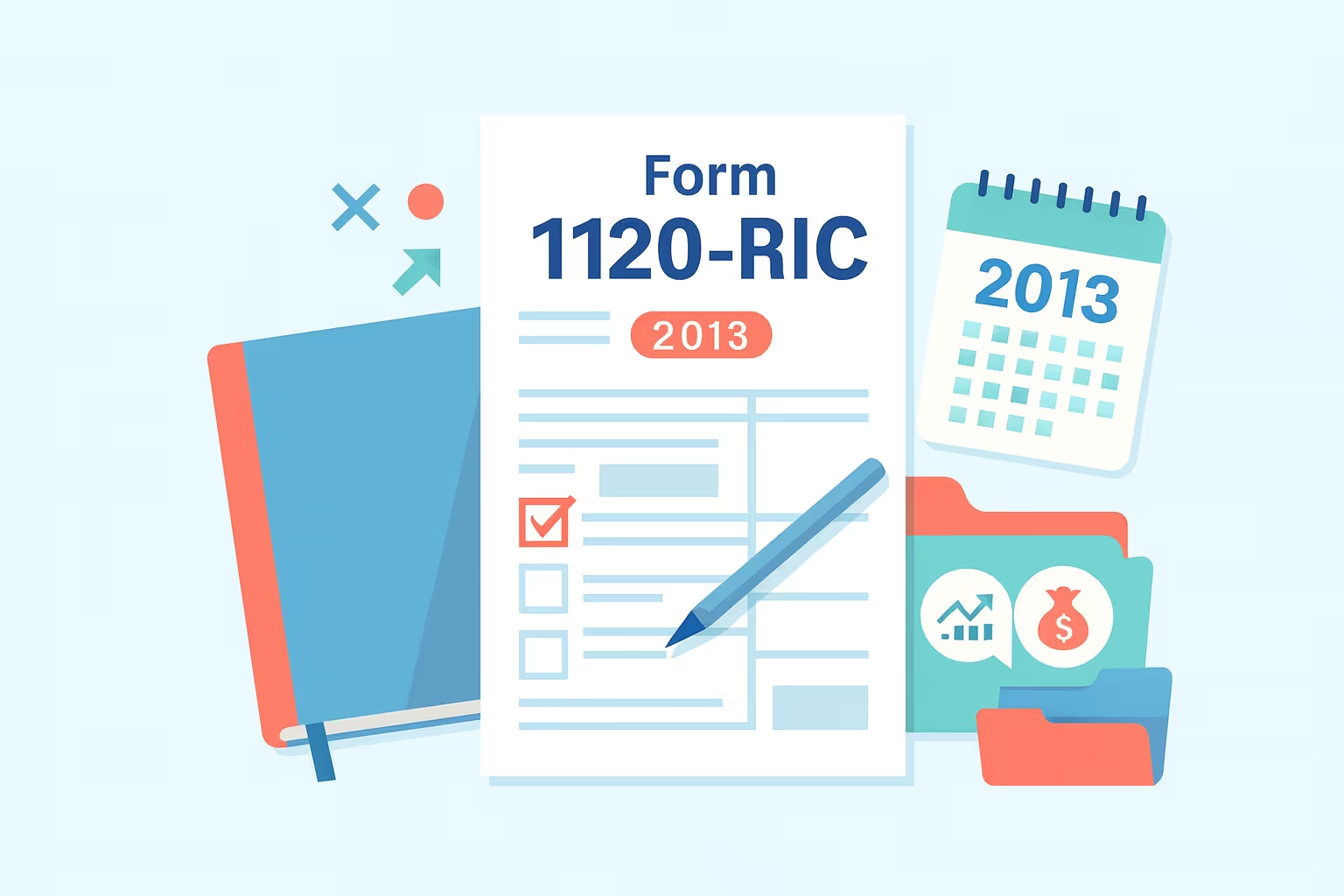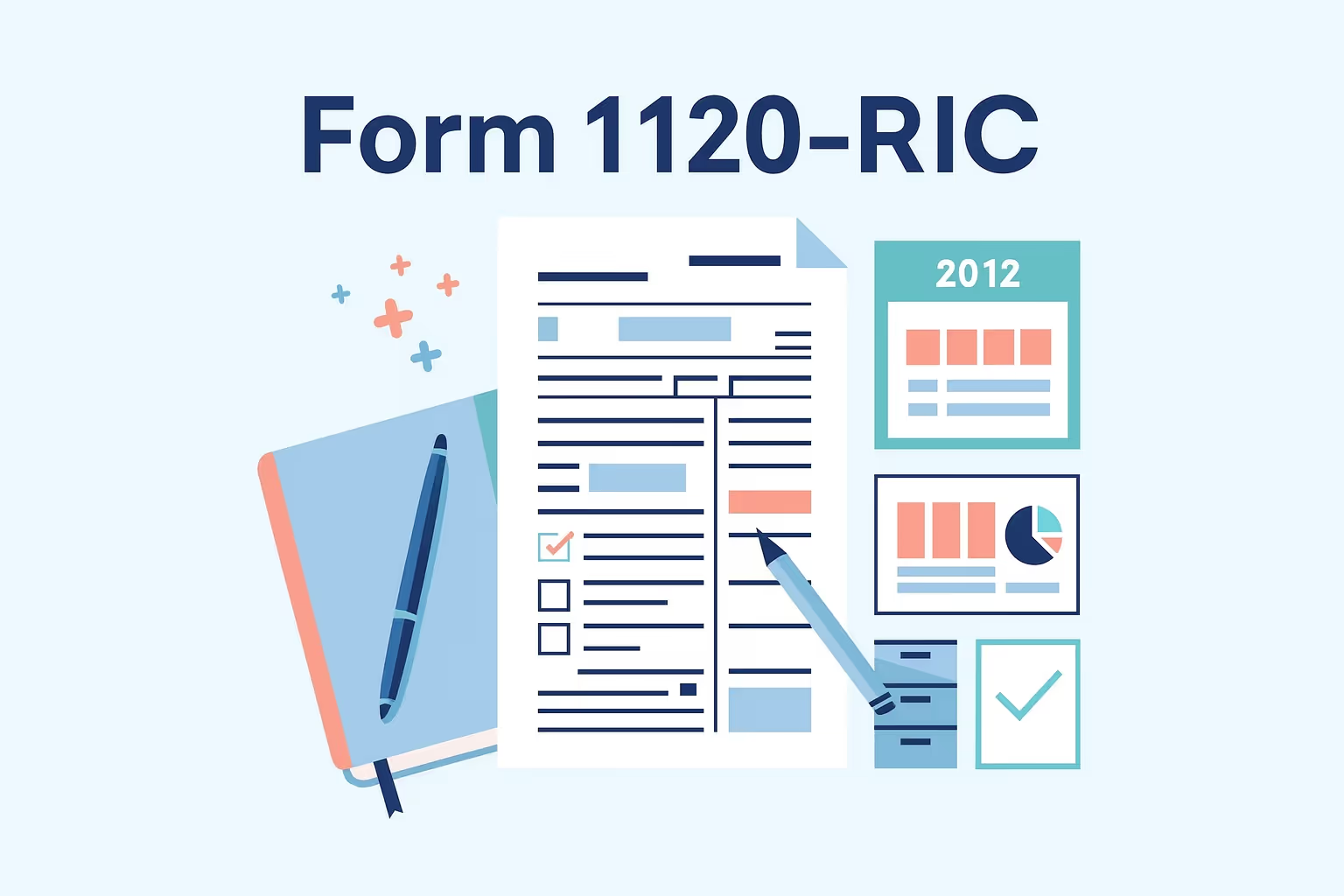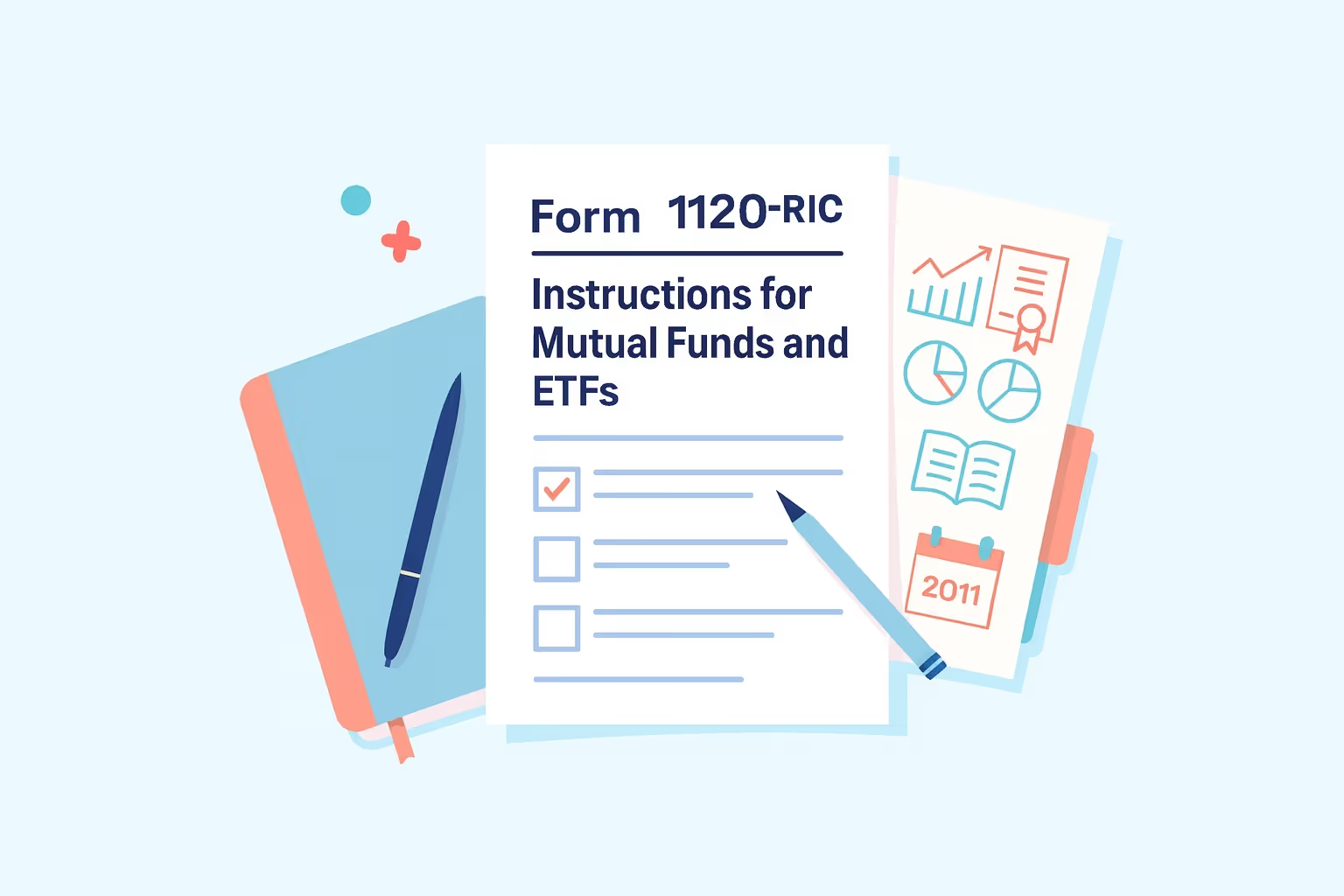Form 1120-RIC 2010 Instructions: Federal Tax Return Help
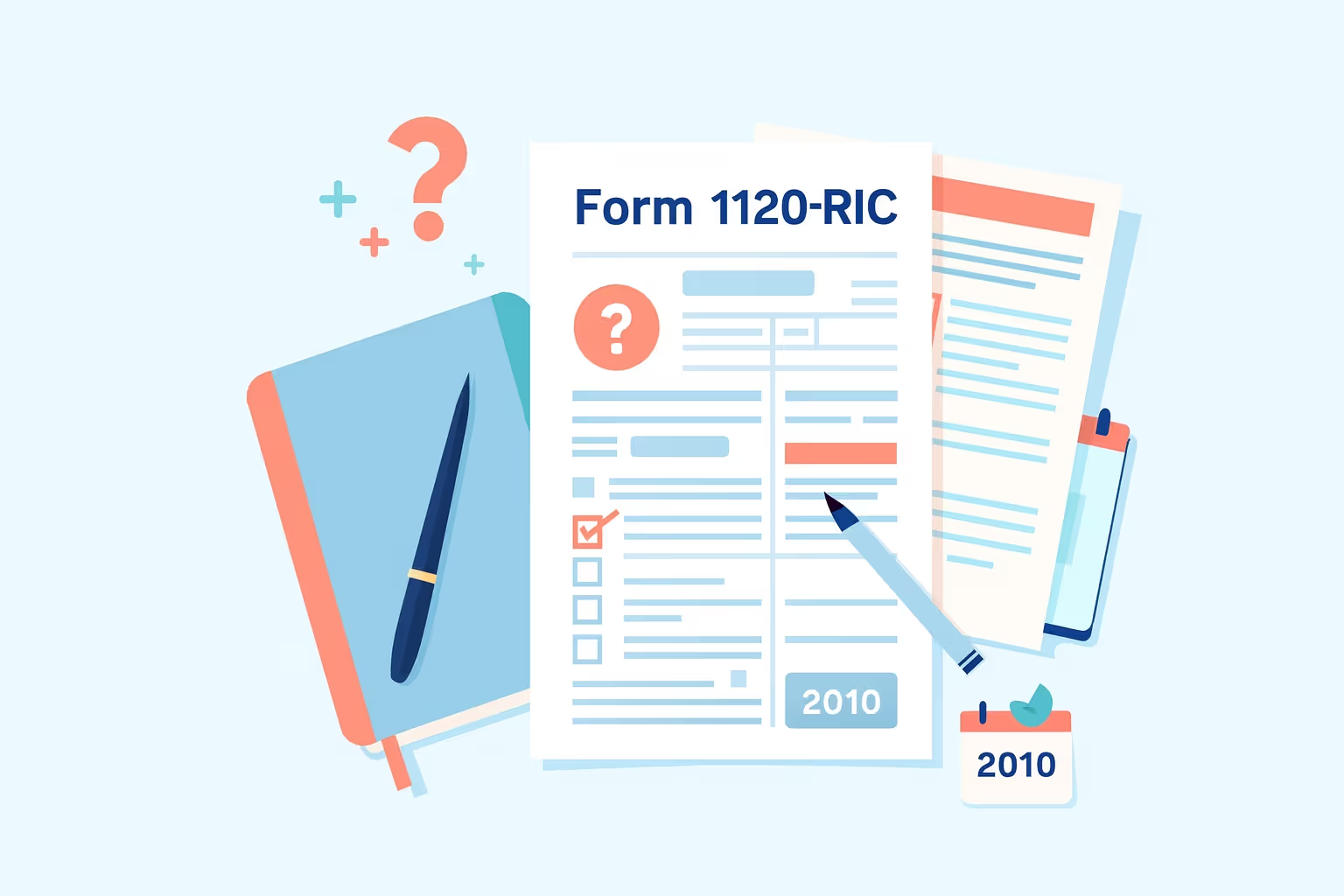
Filing Form 1120-RIC, U.S. Corporation Income Tax Return, is an essential step for Regulated Investment Companies (RICs), including mutual funds, exchange-traded funds (ETFs), and real estate investment trusts. These entities must comply with the Internal Revenue Code under Subchapter M to preserve their special tax treatment, which allows income to be passed directly to shareholders. Accurate reporting of gross income, expenses, credits, and income tax liability helps regulated entities maintain good standing with the Internal Revenue Service.
For companies operating under Subchapter M of the Internal Revenue Code, filing the appropriate return also prevents double taxation and provides transparency regarding the federal tax paid. The form applies to both domestic and foreign corporations electing RIC status, as well as cooperative associations and qualified political organizations. It supports compliance with reporting standards for partnership income, accumulated earnings, and unappropriated retained earnings outlined in federal regulations.
This guide offers clear, structured steps to help you complete the 2010 filing accurately. It simplifies complex provisions, clarifies reporting for specific revenue procedures, and explains how to calculate key figures. The Internal Revenue Service’s 2010 Instructions for Form 1120-RIC outline the required schedules and disclosures filers must review before submission.
Understanding Regulated Investment Companies
Regulated Investment Companies (RICs) operate under the Internal Revenue Code to help entities, such as mutual funds, exchange-traded funds (ETFs), and real estate investment trusts, manage their federal tax obligations. When a company elects RIC status, it may distribute most of its gross income to shareholders.
This approach reduces its overall income tax liability while maintaining compliance with federal regulations. It ensures that profits are taxed only once at the shareholder level, rather than as corporate income and shareholder dividends.
RICs play a vital role in the financial system, providing tax-efficient investment options for both individual and institutional investors. The Internal Revenue Service recognizes RICs as pass-through entities, which allows them to transfer net income and capital gains directly to shareholders.
These distributions must meet qualification standards related to gross income, accumulated earnings, and unappropriated retained earnings. By satisfying these conditions, RICs can avoid double taxation and maintain their special tax treatment under Subchapter M.
Entities eligible for RIC status include:
- Mutual funds and ETFs qualify when they generate income primarily from dividends, interest, and capital gains.
- Real estate investment trusts qualify when they meet the distribution thresholds under federal law.
- Cooperative associations qualify when they engage in qualified investment activities consistent with regulatory guidelines.
- Qualified political organizations and settlement funds qualify when they meet compliance and reporting standards.
- Foreign corporations and foreign persons qualify when they satisfy U.S. source income and distribution requirements.
RIC qualification depends on meeting three key tests each tax year:
- Income Test: The RIC must earn at least 90% of its total gross income from dividends, interest, or gains from the sale of securities.
- Asset Test: The RIC must ensure that no more than 5% of total assets are invested in one issuer and no more than 10% of any issuer’s voting securities are owned.
- Distribution Requirement: The RIC must distribute at least 90% of its taxable income, ensuring that most of its profits flow to shareholders.
Understanding these requirements is critical for accurate reporting on Form 1120-RIC. Filers must also review related regulations, revenue procedures, and credit, deductions, and expenses guidance. Consistent compliance strengthens investor confidence, aligns with Internal Revenue Service expectations, and helps maintain eligibility for RIC tax treatment under Subchapter M.
Federal Tax Requirements for RICs
Regulated Investment Companies (RICs) must meet specific federal standards outlined in the Internal Revenue Code to maintain their favorable tax treatment. These requirements ensure accurate reporting of gross income, net income, and accumulated earnings. They also help RICs avoid reclassification as standard corporations, which would create a higher income tax liability.
- Income Test (90% Requirement): RICs must earn at least 90% of their total gross income from qualified sources, such as dividends, interest, and gains from the sale of securities. Income from foreign persons, foreign sales corporations, and source income related to investments may count when properly documented. Failure to meet this test may result in the loss of RIC status and the imposition of corporate-level taxation.
- Asset Test (Diversification Rule): At least 50% of total assets must be diversified across multiple issuers. A RIC cannot invest more than 5% in a single issuer or hold more than 10% of any issuer’s voting securities. This diversification ensures that investment portfolios remain balanced and aligned with Internal Revenue Service regulations.
- Distribution Requirement (90% Rule): RICs must distribute at least 90% of taxable net income, including dividends and interest, to shareholders. This standard prevents the accumulation of excessive retained earnings and ensures profits are taxed at the shareholder level. It also helps maintain the entity’s pass-through status, which is beneficial for favorable tax treatment.
- Recordkeeping and Reporting Obligations: Companies must maintain records of federal tax paid, unappropriated retained earnings, and credits that reduce income tax liability. Accurate documentation of partnership income, foreign taxes, and cooperative association profits supports compliance with federal reporting standards.
- Controlled Group and Related Persons Regulations: RICs operating under shared ownership or control must follow specific procedures for consolidated reporting. The regulations section defines how controlled groups and certain related persons allocate deductions and credits for proper tax reporting.
Each requirement reinforces transparency and consistency in federal tax reporting. Accurate recordkeeping and verified calculations strengthen compliance and minimize costly adjustments. Many RICs also consult a tax professional experienced in regulated investment reporting to confirm adherence. Following the Internal Revenue Code ensures eligibility for favorable treatment and continued recognition by the Internal Revenue Service.
How to File the Income Tax Return
Filing Form 1120-RIC, U.S. Corporation Income Tax Return, requires careful preparation and adherence to Internal Revenue Service standards. Each step ensures the accurate reporting of gross income, net income, and accumulated earnings while maintaining eligibility for favorable tax treatment under the Internal Revenue Code. A structured filing process minimizes delays, strengthens compliance, and improves transparency in reporting federal tax paid.
Step 1: Gather Essential Information
Assemble all relevant documentation before preparing the return. Include the Employer Identification Number, official fund name, address, date of formation, and total assets at year-end. Collect statements detailing gross income, partnership income, foreign taxes, expenses, credits, and property values for accurate reporting.
Step 2: Complete the General Information Section
Enter identifying details such as the entity’s legal name, Employer Identification Number, and taxpayer identification number. Specify the principal business activity, date of establishment, and classification under the Internal Revenue Code. Confirm that all information matches official filings to avoid discrepancies during IRS review.
For reference, the 2010 IRS Form 1120-RIC (PDF) provides the official structure of each section and schedule, ensuring consistency with Internal Revenue Service requirements. Reviewing the layout helps prevent omissions and supports accurate classification of income and deductions.
Step 3: Report Income and Deductions
In Part I, record total gross income, including dividends, interest, and capital gains. Subtract allowable deductions such as officer compensation, operating expenses, depreciation, and charitable contributions. Include adjustments for partnership income, foreign persons’ income, and unappropriated retained earnings where applicable.
Step 4: Calculate Taxable Income and Liabilities
Use the completed income and deduction data to determine net income and overall income tax liability. Apply any available credits or adjustments based on the regulations section governing controlled group arrangements, cooperative associations, or foreign sales corporations. Confirm that calculations align with current federal tax rates.
Step 5: Attach Required Schedules and Supporting Forms
Include Schedules A (Dividends Paid), J (Tax Computation), and M-2 (Unappropriated Retained Earnings). Attach supporting forms for specific credits, property dispositions, or capital loss adjustments. Verify that attachments are complete, legible, and arranged in proper order.
Step 6: Review and Submit
Double-check all computations, confirm signatures, and verify the accuracy of financial entries. File the return electronically or mail it to the appropriate Internal Revenue Service center. Retain copies of all documents for recordkeeping and future reference.
Completing each stage carefully helps preserve RIC eligibility, maintain accurate tax treatment, and support compliance with federal reporting requirements. A disciplined filing process demonstrates transparency, reinforces the company's credibility with the Internal Revenue Service, and reduces the risk of audit complications.
Form 1120-RIC U.S.: Line-by-Line Overview
Completing Form 1120-RIC U.S. Corporation Income Tax Return requires careful attention to each line and section to ensure compliance with Internal Revenue Service requirements. Each part of the form presents critical information that determines federal tax paid, income tax liability, and the proper application of deductions and credits. Reviewing every entry before submission reduces the risk of misreporting and helps maintain eligibility for regulated investment company status.
Income and Deductions
The first section focuses on reporting total gross income, which includes dividends, interest, capital gains, and revenue from qualified investments. Filers must document all earnings accurately to reflect the RIC’s net income for the tax year. Deductions should include officer compensation, management fees, operating expenses, depreciation, and charitable contributions directly connected to investment activities.
Tax Computation
After entering income and deductions, RICs compute taxable income and determine total income tax liability. Entities can apply allowable credits, including those for tax credit bonds, foreign taxes, and partnership income, to reduce their overall burden. The regulations section under the Internal Revenue Code guides how related persons and cooperative associations should apply these credits and adjustments.
Schedules and Adjustments
Several schedules accompany the main form, each documenting a different component of the RIC’s tax position. Schedule A reports the dividends paid deduction, while Schedule J calculates tax due, including adjustments for foreign persons, capital losses, and excess credits. Schedule L provides balance sheet details, and Schedule M-2 tracks unappropriated retained earnings and accumulated earnings carried forward to maintain transparency with the Internal Revenue Service.
Cross-Form References
Filers may need to include additional forms to address specific reporting requirements. Standard attachments include Form 8613 for excise taxes, Form 2438 for undistributed capital gains, and Form 4562 for depreciation and amortization. Using the correct forms ensures compliance with federal standards and helps the Internal Revenue Service verify calculations for source income and related expenses.
A thorough review of each section ensures that income, deductions, and credits reflect the RIC’s financial position. Clear documentation supports accuracy, reduces potential disputes, and strengthens trust with the Internal Revenue Service. Completing every line properly enhances compliance and preserves the company’s standing as a regulated investment entity.
Electronic Federal Tax Payment System (EFTPS)
The Electronic Federal Tax Payment System (EFTPS) serves as the primary method for Regulated Investment Companies (RICs) to make secure, electronic tax payments to the Internal Revenue Service. Using this system ensures timely deposits, reduces processing errors, and provides verifiable confirmation of all federal taxes paid. Registering and managing payments through EFTPS also strengthens compliance with reporting and payment requirements under the Internal Revenue Code.
What EFTPS Does
- EFTPS allows RICs, foreign corporations, and cooperative associations to submit payments electronically to the Internal Revenue Service.
- EFTPS accurately records all transactions, minimizing calculation errors and supporting federal tax transparency.
- EFTPS simplifies payment tracking with digital receipts that verify deposits and establish documentation for future audits.
Registration and Setup
- Register an Employer Identification Number or Taxpayer Identification Number with the EFTPS portal.
- Provide verified banking information to authorize electronic transfers from designated accounts.
- Complete the initial PIN authentication process to enable secure access to the payment dashboard.
Payment Scheduling and Deadlines
- Schedule payments up to 365 days in advance to maintain consistent federal reporting and avoid delays.
- Meet estimated tax payment deadlines in April, June, September, and December based on the entity’s accounting period.
- Confirm all scheduled payments reflect accurate calculations of gross income, net income, and income tax liability.
Benefits of Using EFTPS
- EFTPS reduces reliance on paper checks and eliminates mail delays associated with traditional filing.
- EFTPS offers confirmation numbers for every transaction to verify payment completion and provide audit support.
- EFTPS enhances accuracy in reporting partnership income, foreign taxes, and other complex transactions.
Recordkeeping and Verification
- Maintain records of all transactions, including confirmation numbers, payment dates, and corresponding income tax periods, to ensure accurate tracking and reporting.
- Review reports regularly to ensure that the federal tax paid aligns with reported amounts on Form 1120-RIC.
- Store documentation with other financial records to demonstrate compliance during Internal Revenue Service reviews.
Access the Electronic Federal Tax Payment System (EFTPS) through the IRS website for guidance on account setup, registration, and payment processing. Proper use of EFTPS supports transparency, accuracy, and timely tax compliance for every RIC filing.
Additional Information and Required Attachments
Regulated Investment Companies (RICs) must include specific schedules and attachments when filing Form 1120-RIC, U.S. Corporation Income Tax Return. These documents provide detailed support for reported gross income, net income, expenses, and credits. Attaching all required forms ensures transparency and helps the Internal Revenue Service verify compliance with the Internal Revenue Code.
The filing includes core schedules and supplemental forms that reflect different aspects of the RIC’s financial position. Each document serves a distinct purpose, whether to reconcile balance sheets, report dividends, or confirm deductions. The following list outlines the most commonly required attachments for a complete and accurate filing.
- Schedule A – Deduction for Dividends Paid: Reports distributions to shareholders from taxable income, including ordinary and capital gain dividends. Proper completion confirms that the RIC satisfies the 90% distribution requirement.
- Schedule J – Tax Computation: Calculates total income tax liability after applying allowable credits, deductions, and adjustments. Confirms that all figures align with taxable income reported on the main form.
- Schedule L – Balance Sheets per Books: Summarizes assets, liabilities, and equity at the beginning and end of the tax year. Completeness supports reconciliation with financial statements.
- Schedule M-1 – Reconciliation of Book Income with Taxable Income: Identifies differences between book income and income reported for tax purposes. Prevents discrepancies that could trigger inquiries from the Internal Revenue Service.
- Schedule M-2 – Analysis of Unappropriated Retained Earnings: Tracks accumulated earnings, retained earnings adjustments, and dividend distributions. Verifies that the RIC manages retained income in compliance with federal regulations.
- Form 8613 – Excise Tax Return: Required for entities subject to the excise tax on undistributed income. Applies to RICs failing to distribute required amounts under Section 4982.
- Form 2438 – Undistributed Capital Gains Tax Return: Reports tax paid on behalf of shareholders for undistributed long-term capital gains.
- Form 4562 – Depreciation and Amortization: Details deductions related to property, equipment, and other depreciable assets.
Including accurate schedules and forms strengthens the RIC’s position during any review and ensures all figures match across related documents. A thorough assembly process reduces filing errors, supports full disclosure, and demonstrates compliance with federal reporting standards. Filers should review their package carefully before submission to confirm every required attachment is present and complete.
Common Errors and Compliance Tips
Accurate filing of Form 1120-RIC U.S. Corporation Income Tax Return depends on avoiding frequent errors affecting favorable tax treatment eligibility. Misreporting income, overlooking deductions, or failing to meet qualification tests can result in reclassification and additional tax liability. Understanding these issues helps Regulated Investment Companies (RICs) maintain compliance with the Internal Revenue Code and the expectations of the Internal Revenue Service.
1. Filing Errors
A RIC creates filing errors when it submits incomplete, inaccurate, or inconsistent information on its return. These mistakes often include incorrect Employer Identification Numbers, omitted schedules, and miscalculated gross income or deductions. Failure to sign or date the return can also delay processing and may expose the filer to unnecessary scrutiny.
Compliance Tip: Verify every entry against supporting documents and ensure totals match across schedules. Consistency between the return, financial statements, and supporting forms builds accuracy and reinforces the credibility of reported figures.
2. Qualification Failures
Qualification failures occur when a RIC fails to satisfy one or more federal tests required under Subchapter M. Failing to meet the 90% Income Test or asset diversification standards can result in taxation as a standard corporation rather than as a pass-through entity. Such outcomes may increase tax liability and disrupt scheduled shareholder distributions.
Compliance Tip: Review income sources, portfolio holdings, and distribution records each quarter. Identifying discrepancies allows timely adjustments to maintain eligibility and compliance with Internal Revenue Code requirements.
3. Reporting Inconsistencies
Reporting inconsistencies involve discrepancies between financial records and the information presented on Form 1120-RIC, the U.S. tax return for RICs. These differences often arise when filers misreport foreign taxes, partnership income, or accumulated earnings. Mismatched data can trigger inquiries from the Internal Revenue Service and delay acceptance of the return.
Compliance Tip: Reconcile all figures with detailed records of foreign sales corporations, controlled group transactions, and cooperative associations to ensure accuracy and completeness. Establishing clear documentation supports transparency and minimizes the need for correction requests from federal agencies.
Each of these issues highlights the importance of precision, consistency, and meticulous oversight. Conducting thorough reviews before submission helps prevent filing errors and preserves full compliance. Working with a tax professional familiar with RIC filings can ensure every calculation, adjustment, and credit meets federal standards.
Frequently Asked Questions
What is the purpose of a tax return for regulated investment companies?
A tax return for regulated investment companies provides detailed reporting of gross income, deductions, and credits to the Internal Revenue Service. It helps establish accurate tax liability while confirming compliance with Subchapter M of the Internal Revenue Code. Filing this return allows regulated entities to maintain pass-through status, ensuring that income is taxed at the shareholder level. Proper preparation also supports transparency, particularly for funds distributing most of their taxable income to investors.
Can a RIC claim an automatic extension to file its return?
Yes, a Regulated Investment Company may request an automatic extension using Form 7004. This extension grants additional time to file the tax return for regulated investment entities, but does not delay payment of federal tax due. To avoid interest and late fees, RICs must estimate their income tax liability and pay any balance by the original due date. Timely payment ensures continued compliance with IRS regulations.
How does a tentative refund apply to an RIC filing?
A tentative refund allows a Regulated Investment Company to recover overpaid federal taxes before the Internal Revenue Service finalizes its review. RICs may claim this refund when adjustments reduce taxable income or increase deductions during the year. To qualify, they must complete the appropriate forms and provide supporting documentation. Accurate reporting of credits and deductions strengthens the claim and ensures prompt processing of refunds through the IRS system.
Are homeowners’ associations or S corporations eligible to file Form 1120-RIC?
No, homeowners’ associations and S corporations are not eligible to file Form 1120-RIC. This form is intended for entities that meet the qualification requirements as regulated investment companies under the Internal Revenue Code. Eligible filers include mutual funds, exchange-traded funds, and similar investment entities. These organizations must satisfy income and asset diversification tests and distribute most taxable income to shareholders to maintain pass-through tax treatment.
When does the Internal Revenue Service issue a notice for RIC returns?
The Internal Revenue Service issues a notice when discrepancies or missing information appear in a submitted return. Common issues include mismatched Employer Identification Numbers, unreported income, or omitted schedules. Submitting complete corrections promptly helps prevent processing delays and potential adjustments to income tax liability. Maintaining organized records of all filings and supporting documentation helps resolve issues efficiently and effectively.
How do interest rates affect RIC tax payments?
Interest rates apply when a Regulated Investment Company underpays its federal tax or fails to submit payments on time. The Internal Revenue Service calculates interest on the outstanding balance starting from the original due date until the balance is paid in full. To avoid added costs, RICs should schedule timely payments, accurately verify income tax liability, and utilize the Electronic Federal Tax Payment System for secure and traceable transactions.
What other forms might accompany a RIC return?
A RIC may need to file other forms depending on its operations and income sources. Examples include Form 8613 for excise taxes, Form 2438 for undistributed capital gains, and Form 4562 for depreciation. Entities with foreign sales corporations, nuclear decommissioning funds, or personal holding company income may also be required to provide additional disclosures. Attaching complete and accurate schedules ensures compliance with IRS standards for tax returns of regulated investment companies.
















